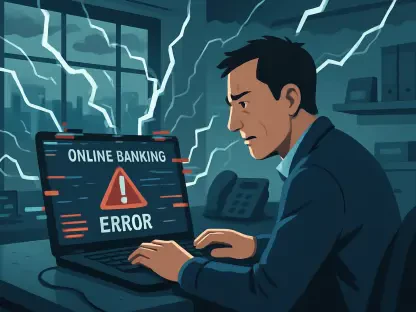What does it take to pull a financial titan back from the brink when competition is fierce and trust is shaken? ANZ Group, Australia’s fourth-largest bank, stands at a pivotal moment with Nuno Matos at the helm as its new CEO. With a bold strategic review rolled out just 100 days into his tenure in 2025, Matos is tasked with reversing years of sluggish performance and reputational scars. The stakes are sky-high in a market that shows no mercy to laggards.
The significance of this story stretches beyond corporate boardrooms. ANZ’s struggles mirror deeper cracks in Australia’s banking landscape, where the Big Four banks face relentless pressure from rivals and regulatory watchdogs. A faltering ANZ could ripple through the economy, affecting mortgage rates, investor confidence, and even job stability for thousands. With Matos’s vision now under the spotlight, the question looms: can one leader redefine a giant’s trajectory?
A Bank at a Crossroads: Can Nuno Matos Steer ANZ to Strength?
ANZ Group finds itself grappling with a perfect storm of challenges as Nuno Matos steps into the CEO role. Once a dominant force, the bank has stumbled with declining market share and operational hiccups that have frustrated stakeholders. Matos’s arrival signals a chance for renewal, but the path ahead is fraught with obstacles that test even the most seasoned leaders.
His initial move—a comprehensive strategic review announced within his first 100 days—has caught the attention of industry watchers. This isn’t just a cosmetic fix; it’s a deep dive into what’s broken at ANZ, from bloated costs to damaged credibility. The urgency is palpable as Matos aims to reposition the bank against a backdrop of cutthroat competition and skeptical investors.
The market isn’t waiting for ANZ to catch up. Rivals like Macquarie Group are aggressively carving out space in key sectors like residential mortgages, while regulatory penalties have added financial strain. Matos must act swiftly to prove that his leadership can deliver not just promises, but tangible results in a sector where patience is thin.
Why ANZ’s Struggles Impact More Than Just Shareholders
The troubles at ANZ aren’t confined to balance sheets or executive suites—they resonate with everyday Australians. As a pillar of the nation’s financial system, the bank’s performance influences everything from home loan affordability to the stability of savings accounts. When a giant like ANZ stumbles, the shockwaves can unsettle consumer confidence across the board.
Beyond individual impacts, there’s a systemic concern at play. The banking sector in Australia is under intense scrutiny, with competition squeezing profit margins for the Big Four. ANZ’s specific woes, including a high-profile bond trading scandal that led to a A$250 million capital penalty, highlight vulnerabilities that could signal broader risks if left unchecked. Regulators and policymakers are keenly observing how this unfolds.
Investors, too, have a vested interest in ANZ’s recovery. With share prices reflecting years of underperformance compared to peers, the pressure is on for Matos to restore faith in the bank’s future. If successful, the turnaround could set a precedent for how legacy institutions adapt in a rapidly evolving financial landscape; if not, the fallout could be a cautionary tale.
Unpacking ANZ’s Hurdles and Matos’s Game Plan
Nuno Matos inherits a complex maze of challenges that demand both precision and boldness. Operational inefficiencies top the list, with certain business units consistently failing to meet benchmarks for customer satisfaction and financial returns. Matos has signaled an intent to streamline operations, pushing for a “sharper and leaner” ANZ that can compete with agility.
Competitive pressures add another layer of difficulty, particularly in the residential mortgage arena where rivals are eroding ANZ’s foothold. Recent figures indicate the bank’s profit margins are contracting faster than those of other Big Four banks, a trend that must be reversed. Additionally, the fallout from the bond trading scandal continues to haunt, exposing flaws in risk management that regulators have pounced on with hefty penalties.
Then there’s the integration of Suncorp Bank, a A$4.9 billion acquisition greenlit before Matos’s tenure. His strategic review includes a hard look at whether this merger is delivering promised value, a critical test of his ability to manage large-scale transitions. These intertwined issues paint a daunting picture, yet they also frame Matos’s plan as a potential pivot point if executed with finesse.
Insights from the Ground: What Experts and Staff Think
Industry voices offer a mixed but hopeful take on Matos’s early moves. A Sydney-based financial analyst noted, “His focus on cultural overhaul alongside cost reductions is a tough but necessary balance—ANZ can’t afford to just slash expenses without fixing its ethos.” This perspective highlights a recognition that numbers alone won’t mend the bank’s deeper issues.
Inside ANZ, the mood reflects cautious optimism after Matos’s staff note in 2025 sparked dialogue among employees. An anonymous department head shared, “It felt like a real call to action, not just corporate speak—we’ve needed this shake-up for a while.” Such feedback suggests internal buy-in, though the challenge remains to translate words into sustained morale and performance.
Leadership shifts under Matos further signal his intent to reshape the bank’s direction. The retirement of key figures like retail banking head Maile Carnegie points to a deliberate restructuring at the top. Combined with external and internal sentiments, these developments indicate that Matos is laying groundwork for change, even if the jury is still out on long-term impact.
Blueprint for Recovery: How ANZ Might Bounce Back
Turning ANZ around requires a clear, actionable strategy tailored to its unique struggles. First, identifying and either revamping or divesting underperforming units is essential—resources should shift toward high-potential areas like digital banking innovations. This focused approach could help recapture lost ground without spreading efforts too thin.
Cost-cutting must be surgical, targeting inefficiencies such as outdated systems while preserving customer service quality. Savings could be redirected into technology that enhances user experience, ensuring ANZ stays relevant. Simultaneously, rebuilding risk culture through mandatory training and independent audits is non-negotiable to prevent repeats of past scandals and regain regulatory trust.
Finally, the Suncorp Bank integration demands strict timelines and measurable goals to avoid value erosion during the merger process. Pairing this with competitive mortgage offerings and a rebranded image of reliability could claw back market share. These steps, balancing immediate fixes with sustainable growth, offer a roadmap for Matos to steer ANZ toward stability and renewed strength.
Reflecting on ANZ’s Path Under Matos
Looking back, Nuno Matos’s early tenure at ANZ was marked by a decisive push to confront entrenched problems head-on. His strategic review became a cornerstone of hope for a bank battered by competition and past missteps. The focus on operational efficiency, cultural reform, and strategic acquisitions like Suncorp Bank set a tone of transformation that many had longed to see.
As the journey unfolded, the emphasis on actionable strategies offered a lifeline for stakeholders eager for results. Moving forward, the critical next step lies in consistent execution—ensuring that cost reductions don’t compromise service and that risk management becomes a bedrock of operations. ANZ’s ability to adapt in real-time to market shifts will be the true measure of this chapter.
Ultimately, the broader lesson from this period was one of resilience and reinvention. For other financial institutions watching, ANZ’s experience under Matos provided a blueprint for navigating crises with clarity and purpose. The road ahead remains open for innovative solutions, perhaps in deeper digital integration or partnerships, to solidify the bank’s place in a dynamic industry.









